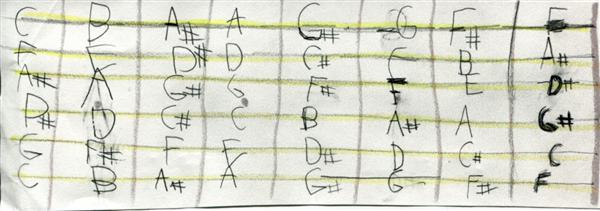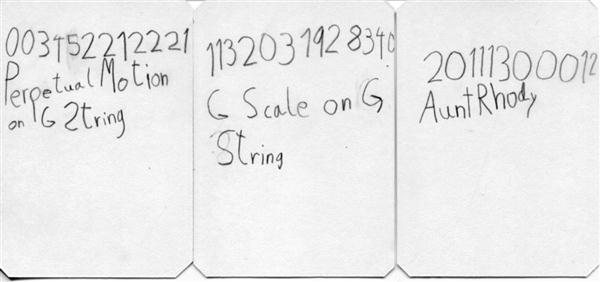M was in a song-and-dance show for her school tonight, and her grandma took us out for dinner afterwards, so we had next to no time for a lesson. In anticipation of this situation, we practiced extra-long yesterday. But I still wanted to get in some off-the-instrument practice as well as a single song on the guitar.
So while waiting for dinner, I had M write the note names on a drawing of the first 7 frets of the guitar. Here it is:

Then on the short ride home, we listened to and sang the Führman Tanz, and I quizzed her on the notes.
We had a problem. M can play this song well (though she doesn’t to have a secure sense of its form; she misses repeats). And she knows the note names. Yet when I asked her what note the B section starts on, she insisted — incorrectly — that it starts on D (it starts on A). She correctly recited the notes of the A section, which does in fact start on D. I asked her to figure out what note the B section started on by doing the left-hand fingering as the song played, but she didn’t do it. In fact, when I said “It’s not D; try figuring out what it is,” she just dug in her heels.
“Okay,” I thought, “I know how to convince her. She agrees that the A section ends on “A-F#-A-F#,” so when we get to that first A (which she admits is A), I’ll sing it on every beat that follows, and she’ll be unable to deny that the B section starts on A — she’ll hear that the note I’m singing is the same as the first note of the B section.”
Wrong times two: I was wrong about how she’d react, and she continued to be wrong about the music. She was so committed to her position that she actually said, “See, it starts on D,” just after she heard me singing A and she heard the B section begin on the note I was singing.
Boy howdy did this push my buttons. I tried to stay in “bemused” territory, but I found M’s stubborn refusal to learn maddening. So I told her so. Basically, I said that I was at a loss: I didn’t care that she was wrong in the first place — everyone’s wrong sometimes — but I was annoyed by, and didn’t know what to do about, her unwillingness to correct, or even see, her mistake. I said that there was no point in arguing, since she was insisting on her position without trying to find out whether it was right, but that we would have to see later, on the instrument, whether she was right. I also said that I was trying to figure out how to react when this type of situation occurs.
When she played the song at home, she imediately recognized her mistake and said, “You win the argument.”
Or course, who cares whether I won that particular argument? I don’t, and I’m pretty sure I told her that. What note this particular song section starts on is meaningless.
But whether M can be open-minded enough to learn, or whether she is so stubbornly defensive that she’ll insist on a point without investigating its truth and in the face of contrary evidence — that’s something that actually matters. And I wish I could react more skillfully when M insists that wrong is right.

